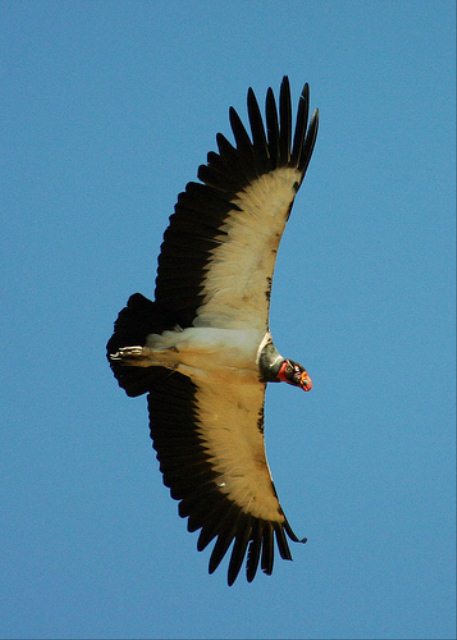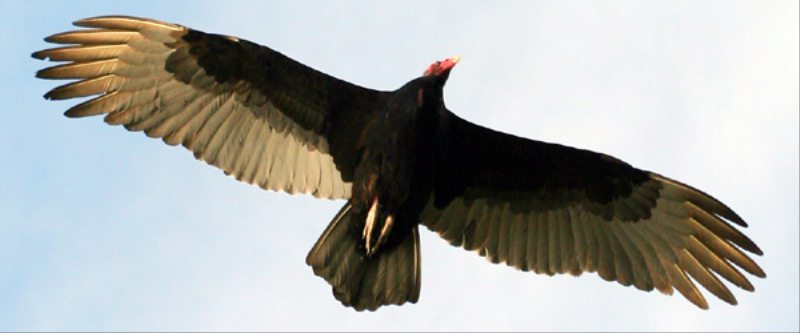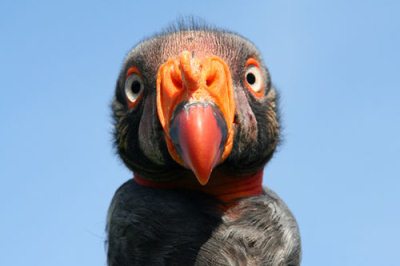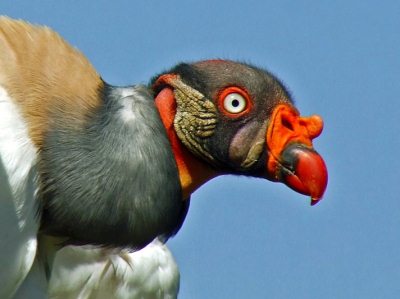Vultures

|
Vultures

The King Vulture, Sarcoramphus papa, is a large bird found in Central and South America. It is a member of the New World vulture family Cathartidae. This vulture lives predominantly in tropical lowland forests stretching from southern Mexico to northern Argentina, though some believe that William Bartram's Painted Vulture of Florida may be of this species. It is the only surviving member of the genus Sarcoramphus, though fossil members are known. It is large and predominantly white, with gray to black ruff, flight, and tail feathers. Its head and neck are bald, with the skin color varying, including yellow, orange, blue, purple, and red. The King Vulture has a very noticeable yellow fleshy caruncle on its beak. This vulture is a scavenger and it often makes the initial cut into a fresh carcass. It also displaces smaller New World vulture species from a carcass. King Vultures have been known to live for up to thirty years in captivity. King Vultures were popular figures in the Mayan codices as well as in local folklore and medicine. Though currently listed as Least Concern by the IUCN, they are decreasing in number, due primarily to habitat loss.
 The Greater Yellow-headed
Vulture, Cathartes
melambrotus, also known as the Forest Vulture, is a species of
bird in the New
World Vulture family Cathartidae.
It was considered to be the same species as the Lesser
Yellow-headed Vulture until they were
split in 1964. It is found in South
America in tropical moist lowland
forests. It is an average
size bird, with a wingspan of sixty five to seventy inches, a weight ten to
thirteen pounds and twenty eight inches long. The body plumage is black, and the
head and neck, which are featherless, range in color from deep yellow to pale
orange. It lacks a syrinx, and its
vocalizations are therefore limited to grunts or low hisses. The Greater
Yellow-headed Vulture feeds on carrion and locates
carcasses by sight and by smell, an ability which is rare in birds. It is dependent on
larger vultures, such as the King
Vulture, to open the hides
of larger animal carcasses, as its bill is not strong enough to do this. Like
other New World Vultures, the Greater Yellow-headed Vulture utilizes thermals to stay aloft with
minimal effort. It lays its eggs on flat surfaces,
such as the floors of caves, or in the hollows of stumps. It feeds its young by
regurgitation.  The Black Vulture, Coragyps atratus, also known as the American Black Vulture, is a bird in the New World vulture family whose range extends from the southeastern United States to Central Chile and Uruguay in South America. Although a common and widespread species, it has a somewhat more restricted distribution than its compatriot, the Turkey Vulture, which breeds well into Canada and south to Tierra del Fuego. Despite the similar name and appearance, this species is unrelated to the Eurasian Black Vulture. The latter species is an Old World vulture in the family Accipitridae (which includes eagles, hawks, kites and harriers), whereas the American species is a New World vulture. It is the only extant member of the genus Coragyps, which is in the family Cathartidae. It inhabits relatively open areas which provide scattered forests or shrublands. With a wingspan of five feet the Black Vulture is a large bird though relatively small for a vulture. It has black plumage, a featherless, grayish-black head and neck, and a short, hooked beak. The Black Vulture is a scavenger and feeds on carrion, but will also eat eggs or kill newborn animals. In areas populated by humans, it also feeds at garbage dumps. It finds its meals either by using its keen eyesight or by following other (New World) vultures, which possess a keen sense of smell. Lacking a syrinx - the vocal organ of birds - its only vocalizations are grunts or low hisses. It lays its eggs in caves or hollow trees or on the bare ground, and generally raises two chicks each year, which it feeds by regurgitation. In the United States, the vulture receives legal protection under the Migratory Bird Treaty Act of 1918. This vulture also appeared in Mayan codices.
 The Turkey Vulture, Cathartes aura, is a bird found throughout most of the Americas. It also known in some North American regions as the Turkey Buzzard and in some areas of the Caribbean as the John Crow or Carrion Crow, here in Trinidad - the Corbeau. One of three species in the genus Cathartes, in the family Cathartidae, the Turkey Vulture is the most widespread of the New World vultures, ranging from southern Canada to the southernmost tip of South America. It inhabits a variety of open and semi-open areas, including subtropical forests, shrublands, pastures, and deserts. A large bird, the turkey vulture, has a wingspan of sixty seven to seventy two inches, a length of twenty five to thirty two inches, and weight of two to five pounds. It has dark brown to black plumage; a featherless, purplish-red head and neck; and a short, hooked, ivory-colored beak. Life expectancy in the wild is upward of sixteen years, with a captive life span of over thirty years. The Turkey Vulture is a scavenger and feeds almost exclusively on carrion. It finds its meals using its keen vision and sense of smell, flying low enough to detect the gasses produced by the beginnings of the process of decay in dead animals. In flight, it uses thermals to move through the air, flapping its wings infrequently. It roosts in large community groups. Lacking a syrinx - the vocal organ of birds - its only vocalisations are grunts or low hisses. It nests in caves, hollow trees or thickets. Each year it generally raises two chicks, which it feeds by regurgitation. It has very few natural predators. In the US, the vulture receives legal protection under the Migratory Bird Treaty Act of 1918.
ALL IN ALL A GREAT GANG.
|

